Written by Tom Moates
The name Martin Black is certainly familiar to Eclectic-Horseman readers from his regular essays in the magazine. Also, his popular books, DVDs, annual clinics, and appearances in issues of The Horseman’s Gazette video magazine help share his horsemanship with many folks.
Martin’s philosophy is rooted in the direct experience, he says, of a life spent with horses while running ranches, often short-handed. The immediacy of needing to get things done on a working ranch, and having an open mind to consider a wide range of approaches with horses, combined to create a natural efficiency in his tactics. One of the main tasks being, not only starting colts, but transitioning them beyond the start and into a working cow horse.
The way Martin approached this transitional period is based both in a philosophy and technique developed over years of intensive ranch work. The success of his methods with colts that go to work as cow horses are evident not only on the lonely expanses of the working ranch but in the crowded atmosphere of the competition arena as well. He has ridden in stock horse events to win over $50,000, with more than half that in NRCHA events, resulting in a string of titles that include Champion and Reserve Champion at the RHAA National Finals and WRCA World Finals Ranch Rodeo Champion and Reserve Champion in the ranch horse competition.
Here, Martin shares his thoughts on what he does to get colts going and through the initial transition towards versatility ranch horse work and that class of competition.
Confidence
If one word could sum up Martin’s advice on getting a colt started and through the transition of beginning in ranch work and/or ready for the show ring it would be confidence. There is not an exact step-by-step method each young horse will follow to get there under his tutelage. There are, however, examples and general themes that can be seen and discussed.

“Events to me,” he says, “are just a job for them. There’s a lot of jobs on the ranch.” Thinking in this way means that for Martin, there is no difference in approach to training for a particular task whether the horse is headed for the show circuit or will never leave the ranch.
Martin spends about a week with green horses getting them started. “I like them to have a good experience,” he stresses. That is the underlying key to building their confidence. If a colt has a bad experience early on, it can cause him to be unsure. He takes care to try and make each step of the journey along the way one that helps the horse to be certain in all he does from accepting the rider to rating cattle.
“Don’t push too much,” Martin warns of that first week. “If the opportunity to move along presents itself, I might do it, but get that confidence first. Don’t crowd the confidence level that first week. I might say, ‘get in here up to this cow.’ It might be a little scary. You have to gauge it.”
At first, he typically works with a young horse from a seasoned mount in a round pen and will use a flag a little to begin preparing the colt for saddling and being ridden. His preference of getting groundwork done from another horse has to do with the fact he works 30 or more horses in a day, and it is a less tiresome method when going sun-up to sun-down than working from the ground. The first saddling happens straight away. Then, getting aboard and getting the horses moving pretty well all happens usually in the first day or two.
Martin had the opportunity to learn some skills from a legendary horseman over the years and shares, “I asked Tom Dorrance one time how he got the buck out of a horse, and he said, ‘I like to leave it all in there, when it comes out is when we have trouble!’” He admits these days he rarely has trouble getting onto a green horse after his initial round pen work.
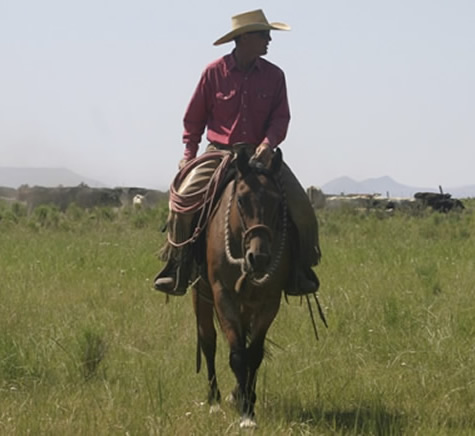
Going to Work
After the first day or two, Martin is riding the young horses and he likes to get them working right away. He might put a colt in front of cattle to see how things progress, or even use the horse for actual work around a ranch.
“I might get in over my head a little,” he admits of this method, “but that’s real life. It’s not all warm and fuzzy stuff. I’m looking to help the horse have the grit to see something through.”
It is a balance he seeks at this point between presenting the horse a dose of reality to get him in an authentic working situation very early in his training and not over-doing it and getting into trouble where a horse’s confidence might suffer. This quickly puts the focus of the progress of the average colt on learning the job rather than just working on cues and exercises—points that can improve while tasks are being undertaken. This real world approach, according to Martin, is healthy for the horse because it gets him into a real setting to work things out right from the beginning rather than keeping him isolated in an “academic” setting, like a round pen, for an extended period of time before he ever learns that the maneuvers being taught have an application out in the world.
“Consider where they are mentally,” Martin explains, “but put them to work.”
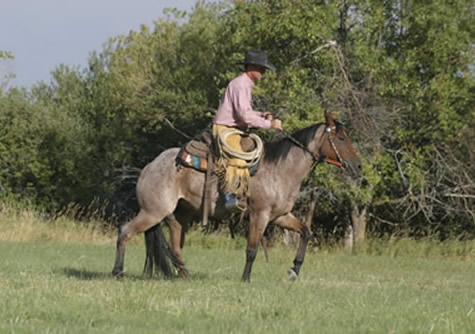
Communication
One large aspect of building a horse’s confidence lies with the rider. It is critical to make clear what you ask of the horse, and to be consistent with those cues. Horses that are unsure of what is being asked of them will be confused. Uncertainty in communication from the rider can undermine confidence because the horse just doesn’t understand what he’s being asked to do. Avoiding such problems is best, but if they are present in a horse they can be worked out.
“If that means taking him back to first grade,” Martin says, “which it usually does…I do.”
Going back to the beginning and starting over with a horse and building back up through his training with consistency in handling and communication can be the key for the problem horse. For the horse just starting, however, Martin reminds folks, “You only have one chance to make first impressions.”
As the early work unfolds and Martin introduces the horse to new experiences he reads the horse’s body language to see how things are progressing.
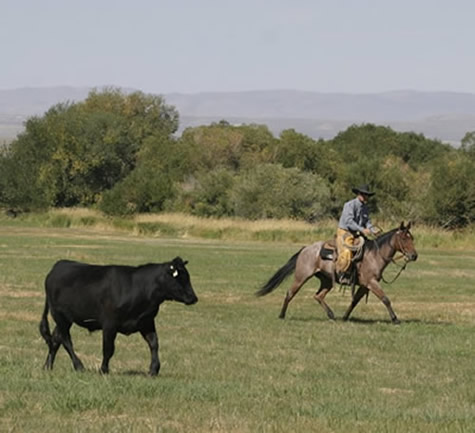
“The meter I need to be reading to gauge their confidence level is stiffness. My definition of ‘supple’ is when the pole and the loin are broke, and that will relate all through the body.”
For instance, if Martin asks a horse for a lateral bend he doesn’t want simply to get the head around to the side and the neck bent, but rather wants that bend to occur all through the body. He wants a total commitment to the bend. It is a condition in the horse’s body he refers to as “softness.”
“The feet gotta be soft,” he explains of this feeling in the horse. “There are two areas I monitor, the movement of the horse and his acceptance.”
In other words, a horse might agree to react to a cue on the rein and move in a certain way but not be real happy about it. The movement is accomplished, but without a deeper willingness from the horse the lack of commitment makes the depth of the movement very shallow in his body. He might be rigid with a level of resistance or even tight and ready to pull back from the movement at any second, unconfident that what the rider is asking of him is safe for him. The opposite of this is a total commitment to what a rider asks. When confident that the rider has his best interests in mind, and clear communication exists between horse and rider, any movement is committed to completely by the horse. This manifests very differently in a physical way within the horse’s body with more muscles dedicated to the requested task, no rigidity in the body, and no rigidity in the mind either. Thus the rider experiences the horse as being “soft.”
Practical Application
Building confidence, clear communication, and getting softness are great concepts to work on with a horse as training progresses for sure but how does this look in practical terms? Martin explains how he might work with a horse early on differently than many people using turn-arounds as an example.
“I do the opposite of what a lot of people do,” he says.
Using pressure and relief are at the base of Martin’s methodology. In the turn-around, he explains, “I get life in the horse’s feet by bringing the life in my legs. The rein just kind of points the direction.”
Once the horse gets close, relaxing the pressure is what lets them know they are getting on track, and then they get relief when they are on track. Martin maintains a rhythm in his body which the horse recognizes and matches. He may occasionally need to adjust the horse with a little rein for direction or bringing life back up through his legs for instance, but typically the horse recognizes the pressure relaxing into the smoothness of the rhythm as an indication that he is locked onto the right idea and movements.
Watching Martin during a turn around, even on a young horse, it is easy to see the reins loose without real contact with the bit. A little contact with the outside leg might be visible, but he says, “there’s no more pressure on my leg than that of a hand on a woman’s back during a dance when you’re leading.”
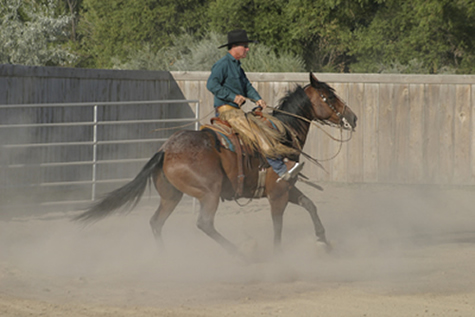
Many people, he explains, increase the pressure on their cues as the horse turns thinking it will increase a horse’s speed and desire to move laterally. This, however, according to Martin, holds off the reward that the horse is seeking for doing the right thing.
“When the pressure is released, they know they’re in the right spot,” he explains, “then they just follow the rhythm.”
If the rider continues to drive the horse around with pressure from a cue once he starts turning, it can cause confusion and unwillingness, not softness and speed. When this happens, the horse thinks the turn may not be what the rider is asking, since he maintains, or even increases the undesirable pressure. The horse may begin to associate the increased discomfort with his turning, and actually feel punished for the turn-around in this scenario. The horse may brace up as a result. Without the willingness and the “softness” that come from clear communication and a total commitment from the horse to the turn-around through his whole body, you are less likely to get a job done well, or score at the top of a class in competition.
Another example Martin shares when getting young horses to transition from the early start and into cow work, is getting the young horse confident at rating and moving cattle. Pressure and release again come into play here. To watch him on a young horse being introduced to cattle, one might find his approach a little counter-intuitive at first. With a green colt, introduction to cattle can run a spectrum of responses from fear and apprehension to excitement and curiosity. Martin will walk a colt towards cattle in the early stages, again being careful to avoid a bad situation that might undermine confidence in the horse. He gets the horse pushing towards the cows and understanding he can move them, thus instilling confidence.
Before long, the horse is rating cattle. The work of communicating to the youngster where his best positions are in regard to getting real cow work done starts here. In this situation, Martin walks the horse up to cattle. When a colt is in good position on a cow, he releases all pressure on the horse. This allows time for the colt to simply stand in that position. To the onlooker, seeing Martin sitting on a horse soaking up the sun for a bit–maybe even for several minutes–it may seem like nothing is going on. That’s exactly the point. When the horse has himself in a good position on the cow, this pause is his reward. According to Martin, this quiet moment also allows time for the horse to soak in the lesson, or “lick and chew on it,” as he says.
The opposite side of this coin is when the horse is not getting into a good position on a cow. Here, as things progress with the young horse, Martin allows him to make the mistake of getting himself into a bad position with cattle. He then requires the horse to hustle and work hard to get things straightened out. That colt now will be exerting plenty of extra effort until he gets around in a good position on the cow to get a break. A few trips down this road, and young horses quickly come around to the more efficient movements of better positioning on cattle and pay attention to how they rate them.
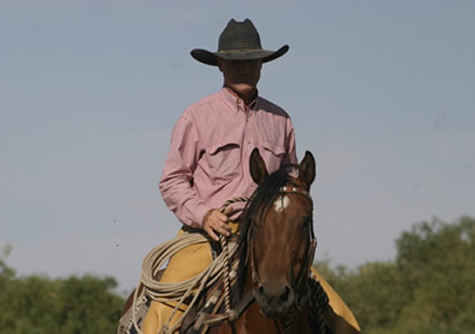
Some horses will have a natural aptitude to excel in certain areas and others will develop more slowly, Martin says to keep in mind.
As the young cow horse progresses towards the show ring, Martin still puts the awareness of confidence central to his training. “I want to show him where his confidence is,” he says. “Problems all start with that one bad experience at a show.”



